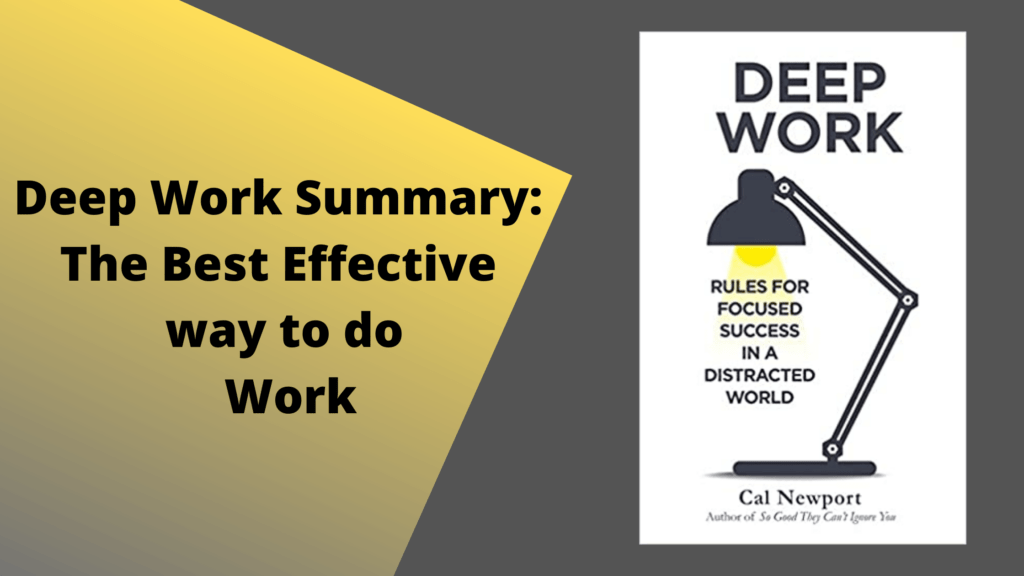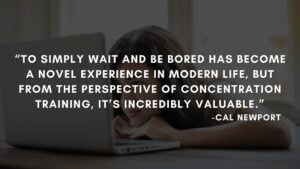Deep Work Summary: The Best Effective way to do Work

This book is about the science of productivity; many of these genre books(self-help) are excellent to read. It was initially published on 5 January 2016. In this book, we learn about many ideas of doing deep work and how this plays a significant role in our lives.
Cal Newport contends that the helpful way to get more significant work done is by working intensely due to working in a state of high concentration without distractions on a single task. Deep work is like a superpower in our increasingly robust twenty-first-century economy.
Best Quote From Deep Work Book:
Here Is The Summary Of Deep Work Book
Cal Newport has divided the book into two categories Deep work and Shallow work.
What Is Deep Work?
Deep work is the capacity to focus on our work without distraction on a cognitively demanding task. It’s an ability that allows you to rapidly master confounded information and generate better results in a limited time. Deep work will make you better at what you do and provide a sense of true fulfillment from craftsmanship. We can say distraction-free work is deep work.
What Is A Shallow Work?
None cognitive mandating logistical technique work, often conducted while Distracted. These efforts tend not to build much new importance globally and are easy to reproduce. In shallow work, people do multiple jobs simultaneously, like checking emails, notifications, etc. This work is giving us low-quality work, and it doesn’t improve the mind, and with this, we can’t achieve anything significant.
Cal also gives us an example of deep work and shallow work.
We all know about bill grates, who’s the founder of Microsoft. He’s a very successful man because he was doing deep work rather than shallow work. Bill Gates did 8 to 9-hour deep work, and still, sometimes he disconnects from the social world and reads a book in an isolated place.
Why Do We Need Deep Work?
The work you do while distracted or semi distracted, robots or any machine will replace this work in the future. So if you don’t have excellent working skills, then many people will do this work at a very cheap rate due to overpopulation and unemployment. In the future Shallow work could be automated.
3 Ways To Get A Habit Of Deep Work:
- Track your habit:- For deep work, we should first train our brain to do some work without any distraction for some hour and also we should fix our time.
- Attention Residue:- when we are working with total concentration, and at that time, if some other distractions happen, our 100 % concentration will break. We will waste 20 to 30% of our engagement, and this 20 to 30% is your attention residue, and by this, our work outcome will automatically decrease, and we have only 70 to 80% concentration are left. This is only happening in shallow works.
- Rest your brain regularly:- we should know when to rest while doing deep work and take a break because it’s essential to take a break; otherwise, we couldn’t focus on our job properly.
Method Of Deep Work
- The monastic approach:- Monastic comes from the monastery, where monks live. This approach says that shutting yourself entirely and focusing on only one thing. Example:- in 1970, bill gates isolated himself from the world for eight weeks, and later, he invented Microsoft.
- The bimodal approach:- This approach is for those who cannot entirely isolate themselves from the world. It prioritizes deep work above everything else. You could set a 4 to 6-hour block each day for deep work, where if you wish, you can lock yourself in your office or anywhere, similar to the monastic approach. However, once that block is over, you’re free to do everything else that might be on your plate.
- The rhythmic approach:- By this approach, we can build a habit of daily deep work. This chunks down your work into time blocks, similar to the Pomodoro technique, and uses a calendar to track your progress. For example, you’d plan your week ahead of time and put ten blocks of 90 minutes on your calendar, and make working with timed blocks a habit.
- The journalists approach:- This approach says that you go into a deep mode when you get the time. If you have a busy daily routine, this works well; you dedicate any unexpected free time to deep work. According to his schedule, Cal Newport follows this approach; he goes too deep mode and works deep on his terms.
Productive Meditation
Making the most unproductive time by doing productive meditation comes down to using your “unproductive” time to do deep thinking. Try to use your free time to love your complex problem in your mind. Next time you have some downtime, you do the abject task, clasp onto a big problem, try to see subproblems of it, break it down, and love it.
Stick On Your Time
Cal has a habit of finishing off his workday at 5:30 pm every day. No emails, no Internet, no to-do lists, no computer after that. Cal taught us to limit ourselves by avoiding work and not checking emails, or, even better, shutting down our computer at the exact time each day. In this way, you’ll have a fixed slot of free time every day to recover.
In the 21st century, only three types of people will survive and prosper in their life:
- First, who has mastered changing technology?
- Second, who are experts in their field and the last businessman, who can hire or invest?
But among all of them, experts in their field will be easy or convenient because, by deep working, we all can be experts in our field.
Productivity= time spent × intensity of focus
So this is the simple equation that helps you understand the summary properly.
So I would like to recommend this book to all the young who aspire to a career as a creative. It is the best book for you all, not for young people but for every age.
Wrapping up
This was a thorough summary of The Deep Work book. If you still have any questions regarding anything, let us know by commenting down. If you liked the content and our efforts then don’t forget to share this with your reader friends.
Sourabh Sharma is a hobbyist book reader, Entrepreneur, and a literature student at Delhi University. A blog writer by day and a book reader by night, he is oathed to discuss himself in a third person but can be persuaded to do so from time to time.




Thanks for the wonderful article…..Really impressed..:-)